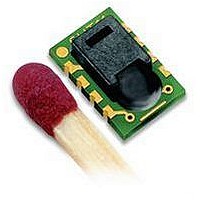SHT15 SENSIRION, SHT15 Datasheet - Page 3

SHT15
Manufacturer Part Number
SHT15
Description
Humidity Sensor
Manufacturer
SENSIRION
Datasheet
1.SHT11.pdf
(11 pages)
Specifications of SHT15
Sensing Accuracy
2%
Sensor Output
Digital
Sensor Terminals
SMD
Humidity Accuracy ±
2%
Peak Reflow Compatible (260 C)
Yes
Terminal Type
PCB Surface Mount
Humidity Range
0 To 100% RH
Response Time
8s
Leaded Process Compatible
Yes
Package / Case
4-LCC SMD
Rohs Compliant
Yes
Lead Free Status / RoHS Status
Lead free / RoHS Compliant
Available stocks
Company
Part Number
Manufacturer
Quantity
Price
Company:
Part Number:
SHT15
Manufacturer:
SENSIRION
Quantity:
1 200
Part Number:
SHT15
Manufacturer:
SENSIRION
Quantity:
20 000
Users Guide SHT1x
www.sensirion.com
1 Application Information
1.1
Sensor works stable within recommended normal range –
see Figure 4. Long term exposures to conditions outside
normal range, especially at humidity >80%RH, may
temporarily offset the RH signal (+3 %RH after 60h). After
return to normal range it will slowly return towards
calibration state by itself. See Section 1.4 “Reconditioning
Procedure” to accelerate eliminating the offset. Prolonged
exposure to extreme conditions may accelerate ageing.
Figure 4: Operating Conditions
1.2
For soldering SHT1x standard reflow soldering ovens may
be used. The sensor is qualified to withstand soldering
profile according to IPC/JEDEC J-STD-020D with peak
temperatures at 260°C during up to 40sec including Pb-
free assembly in IR/Convection reflow ovens.
Figure 5: Soldering profile according to JEDEC standard. T
260°C and t
150sec. Ramp-up/down speeds shall be < 5°C/sec.
For soldering in Vapor Phase Reflow (VPR) ovens the
peak conditions are limited to T
60sec and ramp-up/down speeds shall be limited to
10°C/sec. For manual soldering contact time must be
limited to 5 seconds at up to 350°C
7
233°C = 451°F, 260°C = 500°F, 350°C = 662°F
100
T
T
T
80
60
40
20
P
L
S
0
Operating Conditions
Soldering instructions
(max)
-40
P
< 40sec for Pb-free assembly. T
-20
preheating
0
Normal
Range
Temperature (°C)
20
40
P
7
.
< 233°C during t
critical zone
60
t
L
L
< 220°C and t
80
t
P
100
Version 4.3 – May 2010
Time
P
P
L
120
<=
<
<
IMPORTANT: After soldering the devices should be stored
at >75%RH for at least 12h to allow the polymer to re-
hydrate. Otherwise the sensor may read an offset that
slowly disappears if exposed to ambient conditions.
Alternatively the re-hydration process may be performed at
ambient conditions (>40%RH) during more than 5 days.
In no case, neither after manual nor reflow soldering, a
board wash shall be applied. Therefore it is strongly
recommended to use “no-clean” solder paste. In case of
application with exposure of the sensor to corrosive gases
or condensed water (i.e. environments with high relative
humidity) the soldering pads shall be sealed (e.g.
conformal coating) to prevent loose contacts or short cuts.
For the design of the SHT1x footprint it is recommended to
use dimensions according to Figure 7. Sensor pads are
coated with 35µm Cu, 5µm Ni and 0.1µm Au.
Figure 6: Rear side electrodes of sensor, view from top side.
Figure 7: Recommended footprint for SHT1x. Values in mm.
1.3
It is of great importance to understand that a humidity
sensor is not a normal electronic component and needs to
be handled with care. Chemical vapors at high
concentration in combination with long exposure times
may offset the sensor reading.
For these reasons it is recommended to store the sensors
in original packaging including the sealed ESD bag at
Storage Conditions and Handling Instructions
1.8
1.97
3.48
7.08
2.47
1.07
1.8
Ø0.60
3/11



















